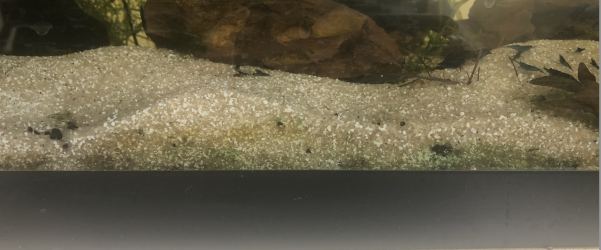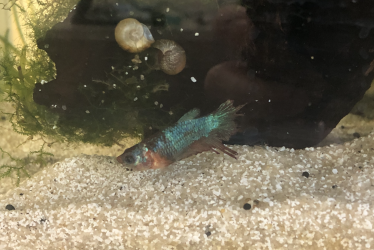fishtime!
Fish Fanatic
My female koi betta's fins have been deteriorating since October, and now they look so bad I'm very concerned. I was told to increase water changes to twice a week and treat the water with vita chem as well as start feeding her betta crumbles in addition to the bugbites I was giving her and soak the food in vitachem before hand. She started getting a bit better, then I had to leave town for the holidays and she got worse. When I got back I resumed and she got a little bit better. Now I've had a few weeks where I've been able to tend to her one week and then not as much the next and she looks so bad. She has never looked underfed - I leave her with an automatic feeder and she has tons of baby shrimp to eat. So the big variable is the water changes. But at worst she is still getting a 50-75% water change every week - 1.5 weeks. I do wipe down the sides of the tank, but I'm wondering if this buildup at the bottom is concerning (picture below). This is NOT in the gravel - I have vacuumed to the bottom in these sections, this is algae on the sides of the tank. So my question is do I have to vacuum all the substrate out of this area and then scrub it off?
I have been considering adding salt because this is so severe but I've never done it before and a lot of stuff online says fin issues should be resolved with clean water. I have seachem polyguard and have been considering api fin and body cure but have not done so because @Colin_T has made posts saying not to unless you know whats wrong. Her behavior is great - always swimming around and exploring the tank, always a good appetite and chases around the pipette i feed her from. I never see here flaring the sides or glass surfing or any other signs of stress. I'm attaching pictures of what she looked like in October, what she looks like now, and what the dirty substrate looks like. I have also turned my aquarium lights off in case that was stressing her out, she gets plenty of light from a nearby window. I also stopped adding almond leaves - I was doing it every water change and I know they are supposed to be good for her but because I was doing so many water changes I was adding 2 each time and I saw one person saying that a lot of decaying almond leaves could harbor fungal growth (even though my shrimps make quick work of the decaying leaves). Should I turn the temperature down to 75 to slow bacterial growth?
Tank info:
Size: 20 gallon long
tank parameters: nitrite 0 ammonia 0 nitrate 5-10 pH 7.5
Stuff in tank: driftwood, dragon rocks, live plants, bladder snails, lots of blue velvet shrimps
filter: 20 g HOB with old carbon filter
temp: 78 F
water changes: bi weekly + gravel vacuum(but read post)
water treatment: seachem prime and vitachem
feeding: twice a day, betta crumbles + fluval bug bites soaked in vitachem



I have been considering adding salt because this is so severe but I've never done it before and a lot of stuff online says fin issues should be resolved with clean water. I have seachem polyguard and have been considering api fin and body cure but have not done so because @Colin_T has made posts saying not to unless you know whats wrong. Her behavior is great - always swimming around and exploring the tank, always a good appetite and chases around the pipette i feed her from. I never see here flaring the sides or glass surfing or any other signs of stress. I'm attaching pictures of what she looked like in October, what she looks like now, and what the dirty substrate looks like. I have also turned my aquarium lights off in case that was stressing her out, she gets plenty of light from a nearby window. I also stopped adding almond leaves - I was doing it every water change and I know they are supposed to be good for her but because I was doing so many water changes I was adding 2 each time and I saw one person saying that a lot of decaying almond leaves could harbor fungal growth (even though my shrimps make quick work of the decaying leaves). Should I turn the temperature down to 75 to slow bacterial growth?
Tank info:
Size: 20 gallon long
tank parameters: nitrite 0 ammonia 0 nitrate 5-10 pH 7.5
Stuff in tank: driftwood, dragon rocks, live plants, bladder snails, lots of blue velvet shrimps
filter: 20 g HOB with old carbon filter
temp: 78 F
water changes: bi weekly + gravel vacuum(but read post)
water treatment: seachem prime and vitachem
feeding: twice a day, betta crumbles + fluval bug bites soaked in vitachem




